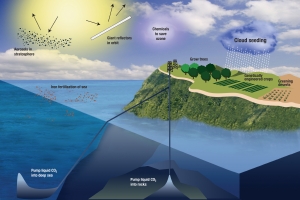May 27 2008
As fossil fuel emissions continue to climb, reducing the amount of sunlight hitting the Earth would definitely have a cooling effect on surface temperatures.
 A schematic representation of various geoengineering and carbon storage proposals. (Diagram by Kathleen Smith/LLNL)
A schematic representation of various geoengineering and carbon storage proposals. (Diagram by Kathleen Smith/LLNL)
However, a new study from Lawrence Livermore National Laboratory, led by atmospheric scientist Govindasamy Bala, shows that this intentional manipulation of solar radiation also could lead to a less intense global water cycle. Decreasing surface temperatures through “geoengineering” also could mean less rainfall.
The reduction in sunlight can be accomplished by geoengineering schemes. There are two classes: the so-called “sunshade” geoengineering scheme, which would mitigate climate change by intentionally manipulating the solar radiation on the earth’s surface; the other category removes atmospheric CO² and sequesters it into the terrestrial vegetation, oceans or deep geologic formations.
In the new climate modeling study, which appears in the May 27-30 early online edition of the Proceedings of the National Academy of Sciences, Bala and his colleagues Karl Taylor and Philip Duffy demonstrate that the sunshade geoengineering scheme could slow down the global water cycle.
The sunshade schemes include placing reflectors in space, injecting sulfate or other reflective particles into the stratosphere, or enhancing the reflectivity of clouds by injecting cloud condensation nuclei in the troposphere. When CO² is doubled as predicted in the future, a 2 percent reduction in sunlight is sufficient to counter the surface warming.
This new research investigated the sensitivity of the global mean precipitation to greenhouse and solar forcings separately to help understand the global water cycle in a geoengineered world.
While the surface temperature response is the same for CO² and solar forcings, the rainfall response can be very different.
“We found that while climate sensitivity can be the same for different forcing mechanisms, the hydrological sensitivity is very different,” Bala said.
The global mean rainfall increased approximately 4 percent for a doubling of CO² and decreases by 6 percent for a reduction in sunlight in his modeling study.
“Because the global water cycle is more sensitive to changes in solar radiation than to increases in CO², geoengineering could lead to a decline in the intensity of the global water cycle,” Bala said.
A recent study showed that there was a substantial decrease in rainfall over land and a record decrease in runoff and discharge into the ocean following the eruption of Mount Pinatubo in 1991. The ash emitted from Pinatubo masked some of the sunlight reaching the earth and therefore decreased surface temperatures slightly, but it also slowed down the global hydrologic cycle.
“Any research in geoengineering should explore the response of different components of the climate system to forcing mechanisms,” Bala said.
For instance, Bala said, sunshade geoengineering would not limit the amount of CO² emissions. CO² effects on ocean chemistry, specifically, could have harmful consequences for marine biota because of ocean acidification, which is not mitigated by geoengineering schemes.
“While geoengineering schemes would mitigate the surface warming, we still have to face the consequences of CO² emissions on marine life, agriculture and the water cycle,” Bala said.